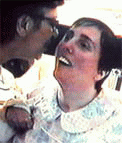
Newly Released Schiavo Tapes Stir Emotion, Debate
News Discussion Forums
Clearwater, Fl. (TNN) - The Pinellas County Court has released four hours of
Terri Schiavo video never before seen by the public.
The video, taken last year without the permission of her husband Michael, shows
Terri smiling at the voice and touch of her mother, following the path of a
balloon with her eyes on several occasions, moaning, and responding to a command
to open her eyes.

The
Schindler's say the most profound evidence that Terri is not in a
"persistent vegetative state" exists in the following sequence of events: Dr.
William Hammesfahr, a Clearwater neurologist asks Schiavo to open her eyes. At
first, her eyelids flutter. She slowly turns her head toward Hammesfahr,
gradually opening her eyes. Then her eyebrows lift into an arch - she appears to
display an expression of astonishment. "Good job!" the doctor exults on tape.
"Good job, young lady!"
Michael Schiavo and his attorney, George Felos, say all the actions exhibited on
the tape are "involuntary reflexes," and are pursuing legal action to have her
feeding tube removed -- again.
Terri Schiavo has been incapacitated for the last 13 years after her potassium
levels dropped so low her heart stopped beating. Doctors say the incident caused
trauma to her brain. But the question of how much trauma is what lies at the
center of the controversy.
"She looks at you, she can follow commands," said Clearwater neurologist William
Hammesfahr. Hammesfahr's opinion was echoed by Drs. William S. Maxfield and John
Young, who have examined Schiavo at her parents' request during the long legal
battle over her fate. Maxfield, a radiologist, said CT scans from last summer
show some damage but not the massive loss of tissue described by others. "People
ought to know she can be rehabilitated," he said.
But doctors hired by Michael's legal team contend Terri isn't aware of anything
and is in a persistent vegetative state. But what does that mean?
In 1994 a Multi-Society Task Force made up of representatives of the American
Academy of Neurology, the Child Neurology Society, the American Neurological
Association, the American Association of Neurological Surgeons, and the American
Academy of Pediatrics produced a Consensus Statement on the Medical Aspects of
the Persistent Vegetative State (PVS).
The Multi-Society Task Force set among its criteria for PVS:
1) No evidence of awareness of self or environment...
2) No evidence of sustained, reproducible, purposeful, or voluntary behavioral
responses to... stimuli;
3) No evidence of language comprehension or expression.
"For most such patients, life expectancy ranges from 2 to 5 years; survival
beyond 10 years is unusual," concludes the Task Force.
Even the term "persistent vegetative state" is controversial -- some medical
dictionaries do not even include the phrase. While standards have been proposed,
they are not accepted by the entire medical community, and methods and
time-frame for diagnostic testing are disputed.
"Some patients are not actually in PVS, but are "locked-in." They may be mute
and immobile but mentally alert and able to communicate by blinking or through
aids such as computers — if someone gives them that opportunity. Others are
severely physically disabled, which greatly impairs their ability to
communicate," says Jane D. Hoyt, M.Ed. Hoyt points to two studies that have
raised eyebrows in the medical community.
• Out of 40 patients diagnosed as being in a persistent vegetative state, 17
(43%) were later found to be alert, aware, and often able to express a simple
wish. The study is one of the largest, most sustained analyses of severely
disabled people presumed to be incapable of conscious thinking, communication,
or awareness of their surroundings. The author, London neurologist Dr. Keith
Andrews, said, "It is disturbing to think that some patients who were aware had
for several years been treated as being vegetative."
• A study of 84 patients with a "firm diagnosis" of PVS found that 41% regained
consciousness by six months, 52% by three years. British Medical Journal,
7/6/96.
"These statistics certainly discredit the terms 'persistent' and 'permanent,'
says Hoyt.
Copyright Tampa News Network 2003